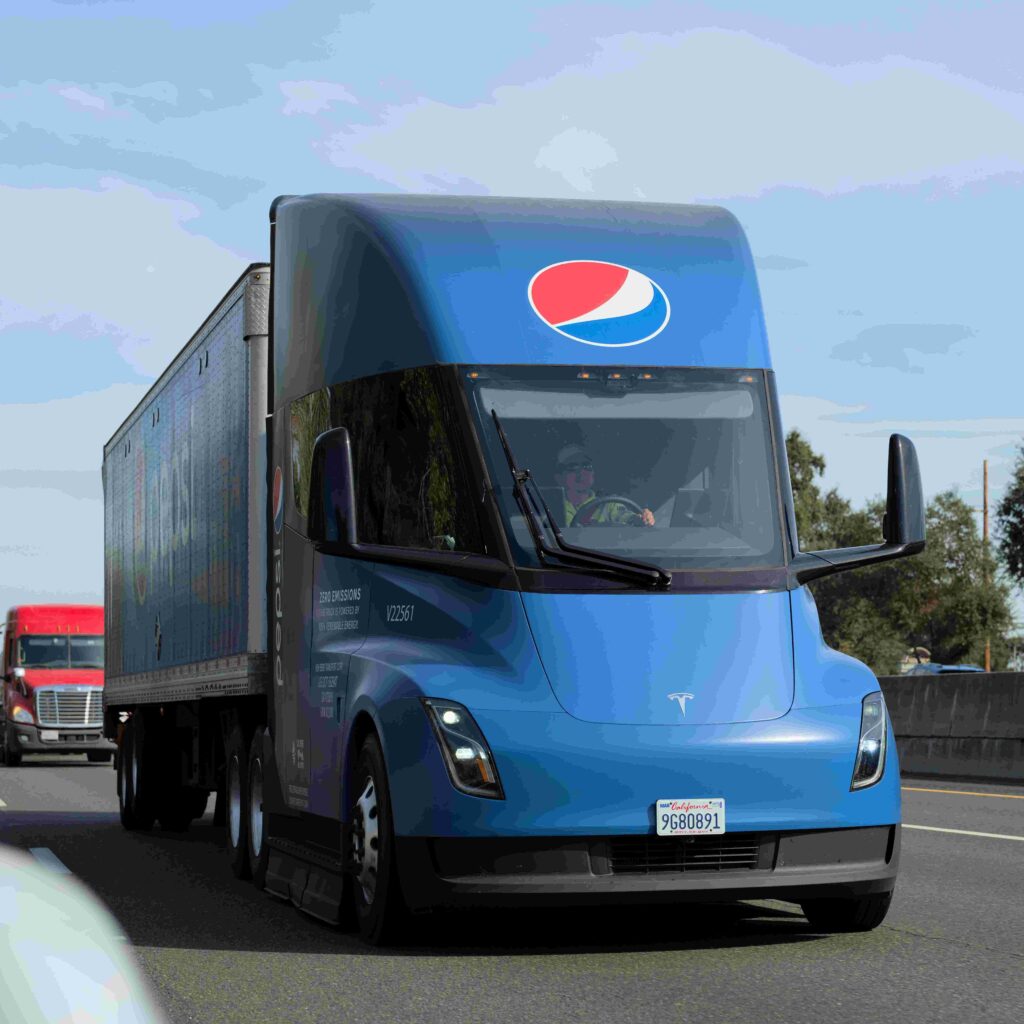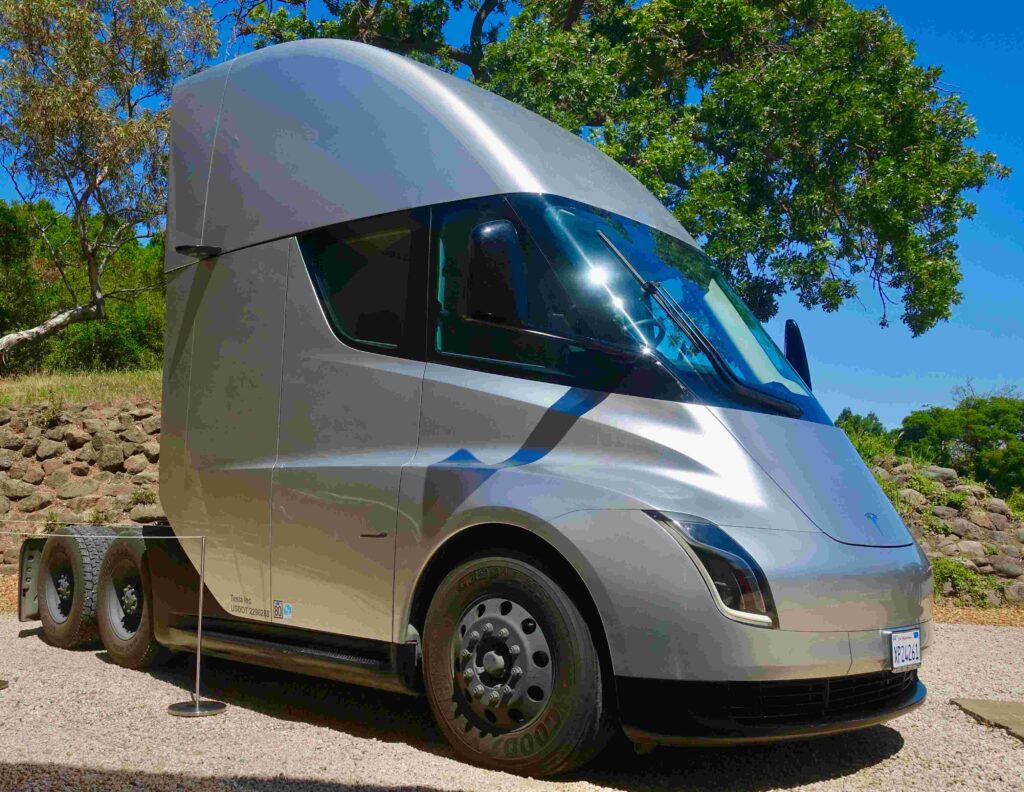Tesla fans and truck enthusiasts have been eagerly awaiting updates on the Tesla Semi, and the 2025 Tesla annual shareholder meeting finally delivered exciting news. Elon Musk revealed a refreshed Tesla Semi, which will begin production in 2026.
This next-generation electric truck promises a combination of futuristic design, increased efficiency, and autonomous capability that could revolutionize the trucking industry. Let’s dive deep into the details of what Tesla has planned for the 2026 Semi.
Tesla Semi 2026 – A Major Update After Years of Waiting
The Tesla Semi was first introduced in 2017, with deliveries beginning in 2022. Since then, production has been extremely limited, with only around 250 units produced, most of which served as prototype test vehicles. Elon Musk has openly admitted that these early semis were essentially beta versions, used to gather feedback before Tesla moves into high-volume production of a more refined model.

With the 2026 refresh, Tesla is finally bringing major upgrades, including improvements to payload capacity, aerodynamics, efficiency, and self-driving readiness. Musk also confirmed that the Semi will be one of three major products entering production next year, alongside Optimus and the Cyber Cab.
Stunning New Design – Futuristic, Sleek, and Aerodynamic
Redesigned Front End and Headlights
One of the most noticeable updates to the Tesla Semi 2026 is its front end design. The new headlights are inspired by the Model Y and Cybertruck, offering a sleek, modern appearance. Unlike the original prototype, which had a striking but conventional headlight design, the new light bar stretches across the front, enhancing aerodynamics and visibility.
Tesla has also updated the front bumper and roofline, with smoother, more rounded contours that reduce drag and improve overall efficiency.
Aerodynamic Improvements for Maximum Efficiency
The current Tesla Semi already boasts an impressively low drag coefficient of 0.36 for a Class 8 truck. The refreshed 2026 version aims to push this further to 0.34, which may seem minor but can reduce energy consumption by 5-7%, translating into tens of extra miles per charge.
For comparison, traditional diesel trucks have drag coefficients ranging from 0.65 to 0.7, highlighting the Semi’s superior wind-cutting ability, smoother acceleration, and reduced wind noise.
Windshield Redesign – Safety and Efficiency Combined
The original Tesla Semi featured an enormous windshield, providing a panoramic cockpit-like view. While visually impressive, it increased wind drag. In the 2026 refresh, the windshield is now narrower and more curved, improving aerodynamics and reducing solar heat entering the cabin.
This update not only improves energy efficiency but also enhances battery cooling and overall safety, making the Semi better suited for long-haul, high-speed travel.
Enhanced Payload Capacity – Haul More With Less
Tesla has stated that the upgraded Semi now supports a higher payload capacity, allowing fleets to transport more cargo per trip. Currently, the gross combined weight (truck plus cargo) is limited to 82,000 lbs, and the refreshed version optimizes weight distribution and efficiency.

The long-range version of the current semi weighs about 23,000 lbs, and Tesla plans to reduce this further, likely with a new battery pack utilizing the innovative 4680 cells, also featured in the Cyber Cab.
Game-Changing Battery Technology – The 4680 Cells
The Tesla Semi 2026 will adopt the 4680 high-voltage (HV) battery cells, a significant step forward in electric truck technology. These batteries offer:
- Energy density up to 290 Wh/kg
- Reduced production costs
- Smaller, lighter battery packs without sacrificing performance
Tesla’s 4680 cells enable the Semi to maintain incredible range, improve aerodynamic efficiency, and lower operational costs, all while allowing for easier manufacturing at the Gigafactory Nevada.
Efficiency and Energy Consumption – Cutting Operating Costs
One of the biggest advantages of the Tesla Semi is its operational efficiency. The 2026 model reduces energy consumption to 1.7 kWh per mile, a 15% improvement over the current version.
By comparison, a diesel truck consumes one gallon every 6.5 miles, costing roughly $0.44 per mile. The Semi costs just $0.30 per mile on electricity in California, nearly 45% cheaper. Over a 100,000-mile annual drive, this translates to $24,000 savings per truck, or $240,000 over ten years—almost the purchase price of the Semi itself.
Lower Maintenance Costs – Electric Advantage
Traditional diesel trucks contain thousands of moving parts: engines, transmissions, clutches, exhausts, and turbochargers, all of which require frequent maintenance.
In contrast, the Tesla Semi uses an electric powertrain with virtually no maintenance requirements. Key benefits include:
- No oil changes
- No spark plugs
- Fewer wear-and-tear components
- Regenerative braking extends brake life by 3-4x
This results in 60-70% lower maintenance costs, further enhancing total cost of ownership.
Performance and Powertrain – Strong and Reliable
The Semi 2026 maintains an 800 kW powertrain output, but Tesla claims internal improvements in cooling, thermal routing, and software ensure consistent performance under load.
The truck also supports 1.2 MW charging, enabling shorter charging stops and improving overall fleet efficiency. Combined with improved aerodynamics, these enhancements make the Semi more competitive with Volvo and Daimler rivals.

Price Speculation – Affordable and Efficient
While Tesla has not announced the official price, experts predict a $160,000 to $190,000 range, depending on configuration and range. Tesla is also considering customizable configurations, allowing buyers to select shorter-range models for lower cost, further reducing the financial barrier for fleets.
Full Self-Driving (FSD) Ready – The Future of Trucking
Tesla’s Semi Gen 2 has been redesigned to support full self-driving hardware, aligning with Tesla’s FSD ecosystem used across the Model 3, Model Y, and Cybertruck.
The truck features a system of cameras, sensors, and radar modules optimized for autonomous highway driving, paving the way for a future fully autonomous electric trucking fleet. This development is especially critical given the driver shortage in the US trucking industry.
Addressing the Truck Driver Shortage – Attracting the Next Generation
The US trucking industry is vital to the economy, moving over 70% of domestic goods. However, the industry faces a critical driver shortage, estimated at 80,000 today and potentially 160,000 by 2030.
Factors contributing to this shortage include:
- Long, exhausting work hours
- Extended time away from home
- Aging workforce
- Low appeal to younger generations
The Tesla Semi addresses these challenges by offering a comfortable, modern driving experience with:
- Central driving position
- 360° visibility
- Dual touchscreen displays
- Advanced driver assistance systems
This tech-forward cabin makes driving an 80,000 lb truck safer, less stressful, and more appealing to younger drivers.
Environmental and Brand Benefits – Reducing Carbon Footprint
In addition to cost savings, the Tesla Semi offers significant environmental advantages. Every 1 million gallons of diesel equals 22,400 metric tons of CO₂. By replacing diesel trucks with electric Semis, businesses reduce emissions, improve sustainability, and enhance brand image.
The Tesla Semi – Revolutionizing the Trucking Industry
The 2026 Tesla Semi represents more than just a truck upgrade. It is a strategic shift towards autonomous, efficient, and environmentally friendly transportation. Key takeaways include:
- Refined aerodynamics for maximum efficiency
- Lighter, powerful 4680 battery pack
- Reduced operational and maintenance costs
- FSD-ready for autonomous highway driving
- Enhanced payload capacity for greater transport efficiency
- Driver-friendly, modern cabin to attract new talent
With these improvements, the Tesla Semi Gen 2 is poised to transform the heavy-duty trucking industry, delivering economic, environmental, and operational benefits that diesel trucks cannot match.

Conclusion – Tesla Semi 2026 is the Future of Freight
Tesla’s next-generation Semi is more than a truck—it’s a technological statement. By combining efficiency, payload optimization, FSD readiness, and cost savings, Tesla is setting a new standard for electric trucking.
The 2026 Semi promises to:
- Slash fuel and maintenance costs
- Increase cargo transport efficiency
- Attract new talent to the trucking industry
- Pave the way for autonomous freight operations
Tesla’s vision is clear: a smarter, greener, and more efficient future for logistics. The Semi Gen 2 isn’t just an upgrade—it’s a revolution.
FAQs
When will the Tesla Semi Gen 2 enter production?
Tesla plans to begin volume production of the Semi Gen 2 in 2026 alongside other major products like the Cybertruck and Optimus robot.
What are the major design changes in the new Tesla Semi?
The Semi features redesigned headlights, a more aerodynamic front end, a smaller curved windshield, and a refreshed chassis for improved efficiency and autonomous readiness.
What is the drag coefficient of the Tesla Semi Gen 2?
The refreshed semi is expected to have a drag coefficient around 0.34, improving aerodynamic efficiency and extending range.
How much payload can the new Tesla Semi carry?
Tesla has confirmed an increase in payload capacity, though the exact figures have not yet been disclosed. It allows fleets to transport more cargo per trip.
What type of battery does the Semi Gen 2 use?
The Semi will use Tesla’s 4680 battery cells, providing higher energy density, lower weight, and improved cost efficiency.
What is the operating range of the Tesla Semi Gen 2?
The long-range version is expected to achieve around 500 miles on a single charge.
How much energy does the Tesla Semi consume per mile?
The new Semi consumes about 1.7 kWh per mile, representing a 15% improvement over the current version.
What is the maximum charging power for the Semi Gen 2?
The Semi supports up to 1.2 MW charging, significantly reducing downtime during long hauls.
How does the Semi reduce operating costs compared to diesel trucks?
Lower electricity costs, fewer moving parts, regenerative braking, and minimal maintenance contribute to savings of up to $200,000–$250,000 over the truck’s lifespan.
Is the Tesla Semi designed for autonomous driving?
Yes, the Semi Gen 2 is FSD-ready, with hardware and sensors designed for future full self-driving deployment.
How does the Semi help address the truck driver shortage?
Its comfortable cabin, intuitive controls, and future autonomous features make trucking less stressful and more appealing to younger drivers.
How fast can the Tesla Semi accelerate?
The Semi can accelerate from 0 to 60 mph in approximately 20 seconds, impressive for a class 8 heavy-duty truck.
How does the Semi compare to traditional diesel trucks in efficiency?
With a drag coefficient roughly half that of diesel trucks (0.65–0.7) and lower energy consumption, the Semi is significantly more efficient on highways.
What are the key interior features of the Tesla Semi?
The Semi features a central driving position, dual touchscreen displays, advanced driver assistance systems, and ergonomic design for long-haul comfort.
What companies are already testing or using the Tesla Semi?
Companies like PepsiCo and Walmart have adopted Tesla Semis for fleet testing and early deliveries.
Will the Tesla Semi be cheaper than diesel trucks?
While the initial price may be higher, operational savings from electricity, maintenance, and efficiency make the total cost of ownership lower than traditional diesel trucks.
Read More:
- Elon Musk’s HORIZONTAL Starship Moon Landing Method Without Legs Shocked NASA
- Tesla teases new market entrance with confusing and cryptic message
- Elon Musk hints at when Tesla can fix this FSD complaint with v14
- Tesla Australia celebrates 150k vehicles on domestic roads
- Jim Farley admits he was “humbled” when Ford tore down Tesla and Chinese EVs
- Tesla Superchargers to be opened for VW ID.4 and ID. Buzz owners

